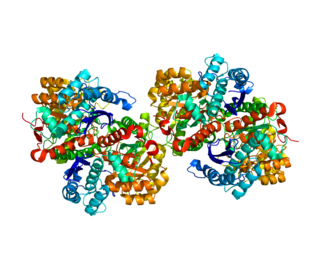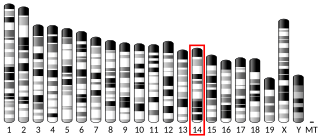
Enolase 1 (ENO1), more commonly known as alpha-enolase, is a glycolytic enzyme expressed in most tissues, one of the isozymes of enolase. Each isoenzyme is a homodimer composed of 2 alpha, 2 gamma, or 2 beta subunits, and functions as a glycolytic enzyme. Alpha-enolase, in addition, functions as a structural lens protein (tau-crystallin) in the monomeric form. Alternative splicing of this gene results in a shorter isoform that has been shown to bind to the c-myc promoter and function as a tumor suppressor. Several pseudogenes have been identified, including one on the long arm of chromosome 1. Alpha-enolase has also been identified as an autoantigen in Hashimoto encephalopathy.

Cyclin D1 is a protein that in humans is encoded by the CCND1 gene.

Serine/threonine-protein kinase PAK 2 is an enzyme that in humans is encoded by the PAK2 gene.

Cell division protein kinase 8 is an enzyme that in humans is encoded by the CDK8 gene.

Serine/threonine-protein kinase PAK 4 is an enzyme that in humans is encoded by the PAK4 gene.

Growth arrest and DNA-damage-inducible protein GADD45 gamma is a protein that in humans is encoded by the GADD45G gene on chromosome 9. GADD45G is also known as CR6, DDIT2, GRP17, OIG37, and GADD45gamma. GADD45G is involved in several different processes, including sexual development, human-specific brain development, tumor suppression, and the cellular stress response. GADD45G interacts with several other proteins that are involved in DNA repair, cell cycle control, apoptosis, and senescence. Low expression of GADD45G has been associated with many types of cancer.

Metastasis-associated protein MTA2 is a protein that in humans is encoded by the MTA2 gene.

PIN2/TERF1-interacting telomerase inhibitor 1, also known as PINX1, is a human gene. PINX1 is also known as PIN2 interacting protein 1. PINX1 is a telomerase inhibitor and a possible tumor suppressor.

Metastasis-associated protein MTA3 is a protein that in humans is encoded by the MTA3 gene. MTA3 protein localizes in the nucleus as well as in other cellular compartments MTA3 is a component of the nucleosome remodeling and deacetylate (NuRD) complex and participates in gene expression. The expression pattern of MTA3 is opposite to that of MTA1 and MTA2 during mammary gland tumorigenesis. However, MTA3 is also overexpressed in a variety of human cancers.

Cyclin-dependent kinase 2-associated protein 1 is an enzyme that in humans is encoded by the CDK2AP1 gene.

Serine/threonine-protein kinase PAK 6 is an enzyme that in humans is encoded by the PAK6 gene.

In molecular biology, mir-145 microRNA is a short RNA molecule that in humans is encoded by the MIR145 gene. MicroRNAs function to regulate the expression levels of other genes by several mechanisms.

miR-214 is a vertebrate-specific family of microRNA precursors. The ~22 nucleotide mature miRNA sequence is excised from the precursor hairpin by the enzyme Dicer. This sequence then associates with RISC which effects RNA interference.

GTP-binding protein Di-Ras3 (DIRAS3) also known as aplysia ras homology member I (ARHI) is a protein that in humans is encoded by the DIRAS3 gene.

MicroRNA 489 is a miRNA that in humans is encoded by the MIR489 gene.

BRAF-activated non-protein coding RNA is a noncoding RNA that in humans is encoded by the BANCR gene. Long non-coding RNAs (lncRNAs) are involved in the intricate network of cancer and contribute significantly to tumorigenesis and progression. BRAF activated non-coding RNA (BANCR), a 693-bp four-exon transcript, was first identified in 2012 as an oncogenic long non-coding RNA in BRAFV600E melanomas cells and was found to be associated with melanoma cell migration. Apart from melanoma, growing evidence has implicated BANCR in the development and progression of a variety of other human malignancies, including retinoblastoma, lung cancer, and gastric cancer, since its discovery. The pattern of expression of BANCR varies according to the kind of cancer, acting as either a tumour suppressor or an accelerator. Functional BANCR may be a useful biomarker for cancer diagnosis and prognosis assessment. BANCR-targeted therapy may also prove to be a promising new treatment option for human cancers.

MicroRNA 495 is a protein that in humans is encoded by the MIR495 gene.

SRY-box 7 is a protein that in humans is encoded by the SOX7 gene.

MIR22HG, also known as C17orf91, MGC14376, MIRN22, hsa-mir-22, and miR-22 is a human gene that encodes a noncoding RNA (ncRNA).This RNA molecule is not translated into a protein but nonetheless may have important functions.






















